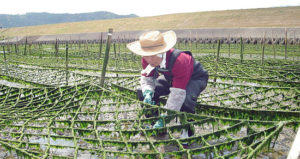
Nori farmer, Shimanto, Japan. Source: Wiki commons “the Story of the Seaweed Lady” http://www.thenutgraph.com/the-story-of-the-seaweed-lady/
Transition in nori cultivation : evolution of household contribution and gendered division of labor
by Dr A. Delaney ad@ifm.aau.dk
In Cahiers de Biologie Marine Link
[CdBM (2011) Vol 52(4):527-533]
Abstract: Consumers throughout the world have gained familiarity with the seaweed nori (porphyra spp) thanks to the popularity of Asian cuisine, particularly Japanese sushi. Few actually know much about the people who produce this seaweed, however. This article presents qualitative social science research undertaken in Northeastern Japan among a community of nori cultivators on their production process and cultural way of life. Natural scientists acknowledge that in order to manage natural resources, it is actually the resource users who must be managed. In order to manage resource users, with the goals of social and environmental sustainability, we must understand both society and cultural institutions. With this in mind, this article focuses on the division of labor among cultivators, particularly along gender lines and the impacts, on a cultural level, of technological change on nori production. Technological change has had a profound impact on both the manner of nori production as well as the household division of labor and work and gender roles. Women play a key role in nori production today. With better understanding of such outward manifestations of culture and society we can bring the human dimensions of systems to bear in order to better manage these, and other natural resources.
Some additional information: A big breakthrough in closing the life-cycle for nori came in 1949 when Japanese researchers saw the publication of a British scientist, Dr Kathleen Drew-Baker, on the reproduction of a related species. Dr Drew-Baker is still honored in Japan for her findings, including by a memorial at Uto City, Japan (see http://en.wikipedia.org/wiki/Kathleen_Mary_Drew-Baker for an introduction). Thanks to my friend Choo Poh Sze for alerting me to Dr Drew-Baker’s work some years ago. Dr Delaney informs me that she has mentioned Dr Drew-Baker also in her thesis from which this paper is drawn.
See also this article on Dr Drew-Baker and nori culture from National Geographic
This entry was posted in: Gender, Men, Women
